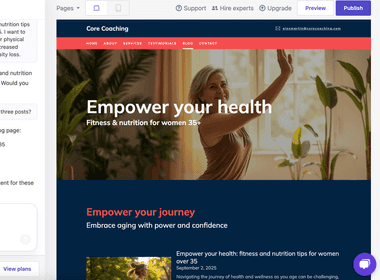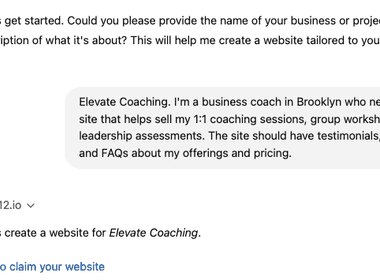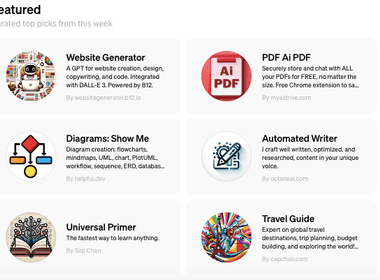MixTAPE: Mixed-initiative Action Plan Creation for Teams
This blog post summarizes a paper that investigates a mixed-initiative approach for creating action plans for team-based projects. We’ll be presenting this paper at the 23rd ACM Conference on Computer-Supported Cooperative Work and Social Computing (CSCW) on Tuesday October 20 at 7am CT.
By Sajjadur Rahman, Pao Siangliulue, and Adam Marcus
Checklists and action plans are effective mechanisms for task-based collaboration. From the aviation industry to hospitals, digital media to education, they enjoy widespread adoption across domains. Therefore, it’s no surprise that software for creating checklists and action plans has turned into a billion-dollar industry.
While the importance of checklists and action plans is undeniable, the plan creation process for projects, specifically those that involve multiple stakeholders, can be challenging. Project managers have to consider multiple sources of information and requirements, from structured survey input to semi-structured interviews and conversations with stakeholders, and then consolidate these sources into an action plan with clear and succinct tasks for the collaborators to act on. Therefore, the quality of the synthesized plans has a far-reaching impact on factors like project completion and team collaboration. Addressing the challenges in creating action plans is thus crucial to having high-quality outcomes.
To better understand the challenges and potential solutions around collaborative action plan creation, we studied B12’s website design projects. These projects involve multiple stakeholders like project managers, designers, and clients and interviewed project managers about their plan creation experience. Based on these interviews, We identified several key challenges in action plan creation for team-based projects. From these findings, we developed MixTAPE, a mixed-initiative action plan creation tool for synthesizing multi-source information into action plans and for enabling collaboration among stakeholders.
Through a user study on real customer projects at B12 , we find that compared to a previously unstructured process, MixTAPE generated 1.45X as many tasks that are more consistent, while reducing the plan creation time by 33.70%. Interviews and surveys surfaced that participants rate MixTAPE highly across several measures. In this post, we’ll summarize what we learned through the research and where to go from here!
Plan creation is err…HARD
Before proposing any solutions, we studied how project managers created web design action plans at B12 using Google Docs. We found that action plan creation is a multi-step process. Project managers need to collect requirements, synthesize them into action plans, and annotate the tasks with owners and priorities. Our pilot study surfaced challenges at every step of plan creation.
1) Collecting requirements during a live conversation
Live note-taking is difficult! One important source of input for collaborative projects is a live conversation involving note-taking: think of the kickoff or check-ins you’ve had on a recent project. Live conversations are dynamic and can quickly change course, making it difficult to capture all of the crucial details of a project. Taking notes during a live conversation was difficult in part because rich text editors like Google Docs lack structure making it challenging to consistently capture information.
2) Manual and error-prone task synthesis
After collecting requirements, project managers need to synthesize information from multiple sources into action plans. However, sources like call notes and surveys, since they are captured in different formats, at different times, and from different stakeholders, may contain conflicting or redundant information. Moreover, the presentation of the compiled plans may vary across projects. For example, plans were presented as a list or paragraph.
3) Task annotation is tedious
After synthesizing plans, project managers had to manually assign tasks to different collaborators, which was time-consuming. The presentation and communication of task priority (e.g., must-have, nice-to-have) were inconsistent across projects. Some used a sorted list, while others used colored or bolded text to convey priority. This variation was confusing for other collaborators. Ownership annotation (e.g., will the designer upload the images, or the customer?) was also tedious and inconsistently communicated.
Enter MixTAPE
These challenges can be seen not only at B12 but in many situations that require the creation of shared action plans. With the challenges in mind, we developed MixTAPE to make action plan creation easier, faster, and less error-prone. MixTAPE features a semi-structured notepad for ease of note-taking and an automated synthesizer and annotator to reduce manual effort during plan synthesis. In a mixed-initiative fashion, humans review and curate machine-generated plans and then collaborate.
MixTAPE’s components. We reference individual screens (a-e) below to describe what each purpose each screen serves
1) Semi-structured note-taking
Project managers take notes in a notepad structured into various sections related to a website (e.g., structure, design, content, functionality) (a). Project managers can take notes using a markdown-like language that distinguishes tasks/action items (lines preceded with a dash) and additional details (lines preceded with a double dash). The notepad is also equipped with an autocomplete model to assist during live note-taking.
2) Automated task synthesis
When the project manager clicks the convert button, tasks in the notepad (a) and tasks generated from client surveys (b) are automatically grouped into sections resulting in a structured presentation of action plans (c).
3) Task assignment, prioritization, and curation
Pre-trained classifiers automatically assign each task to a specific role (e.g., client, designer, project manager) while adding priority (e.g., low, high, medium) to a task (c). Project managers can review the annotated tasks and update any assignment if required (d). They can remove conflicting or redundant tasks and add additional comments or even new tasks if required.
As they follow the action plan and perform tasks, collaborators can update the task status as pending, completed, or declined (e).
MixTAPE has been deployed for creating action plans for website design projects at B12 for over a year, and has simplified action plan creation for many thousands of projects beyond just the initial web design use case. Check out our paper at CSCW 2020, where we report promising results from a study comparing MixTAPE with using Google Docs for note-taking and action plan creation across 32 new website design projects. Here are some quotes from the study:
“I feel like I’ve had more positive launches [with MixTAPE] lately. I haven’t gotten any client feedback like the website is missing something.” (Project Manager)
“With the new tool [MixTAPE], I have noticed I have been getting less clarifying questions from the designers.” (Project Manager)
“It’s great to have a project broken down into its component steps, which forces specificity.” (Designer)
Looking ahead: adoption and generalizability
Over the past year, MixTAPE has helped launch thousands of website design projects at B12. This success has led to the adoption of MixTAPE for managing plan creation in other types of projects at B12: copywriting projects and website enhancement projects. These projects have different processes and team structures from website creation projects. For example, a copywriting project (e.g., writing a blog post, editing product descriptions) involves a superset of the team a traditional web design project requires, adding team members like copywriters and SEO specialists So far, the teams have successfully adapted MixTAPE to different workflows and different sets of collaborators.
While we are confident that the learnings from MixTAPE apply to the creation of action plans for a broad variety of teams. It’s worth considering how to reduce the domain-specific work required to apply the system to other domains. The majority of the components of MixTAPE (i.e., the task synthesis algorithm, task management pane, and task view) are relevant for any domain that requires team-based task creation and management. While the markdown language-based note-taking pane is also generalizable, the structure of the pane will vary based on the domain. On the other hand, training models for owner/priority assignment would require the creation of a domain-specific corpus, and we look forward to future work that explores how to generalize these models.
MixTAPE is a first step toward mixed-initiative project management. We look forward to a future in which deep system support for semi-structured note-taking, automated task synthesis, and task classification form the basis of any collaborative toolkit. If you’re interested in learning more or collaborating, reach out at CSCW or online (Sajjadur, Pao, and Adam)!
Read next
See all
B12’s AI Agent: Take the work out of your website
Improve your website just by typing what you want
Read now
Trusted by 1M+ users: Our most personalized Website Generator yet
Build custom websites faster, add new pages in seconds, and manage multiple sites effortlessly
Read now
OpenAI features B12’s Website Generator in the GPT Store
Create and customize your website directly in ChatGPT using DALL-E
Read now

